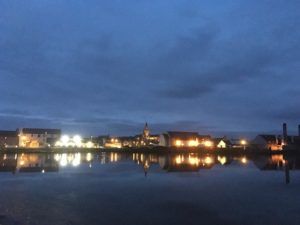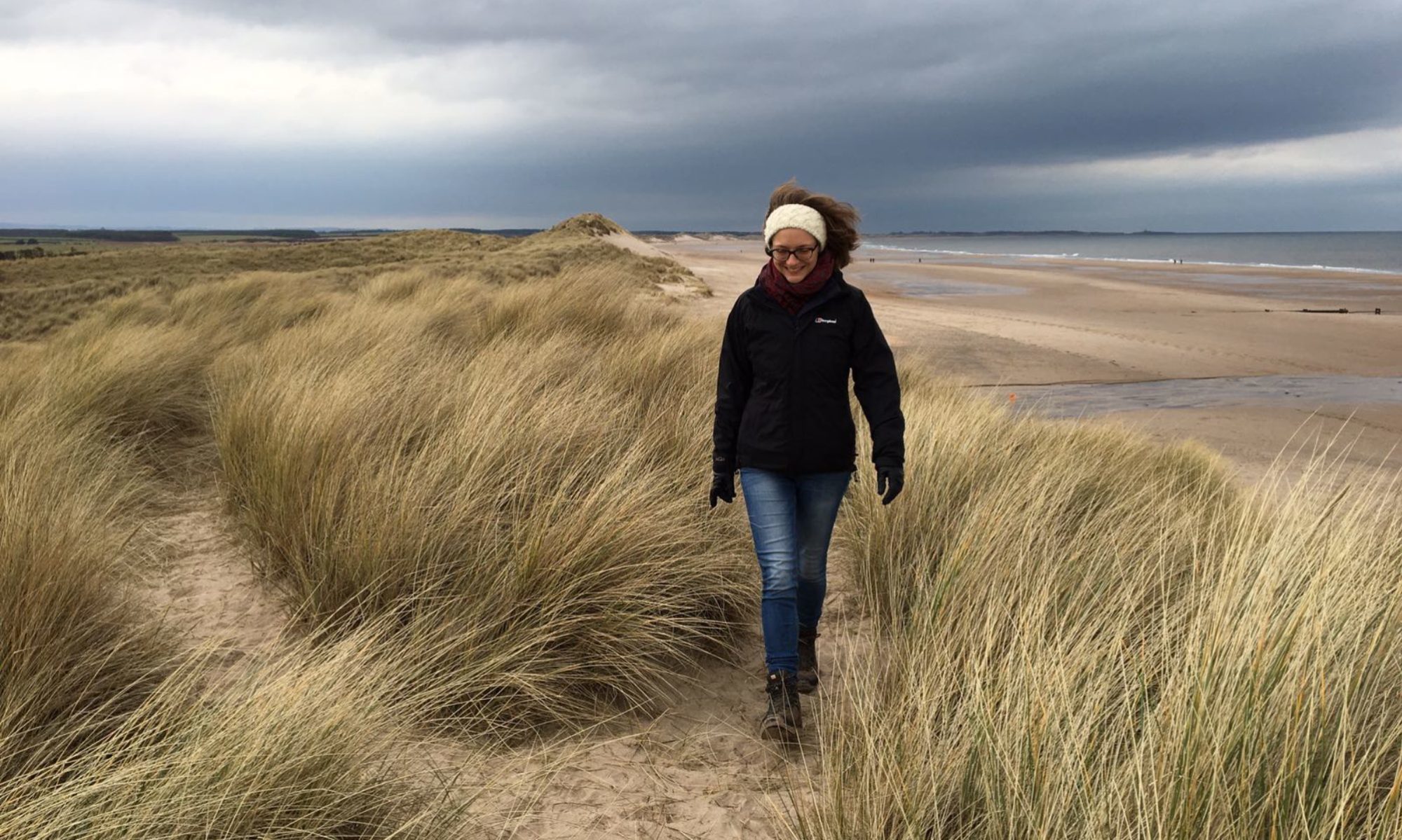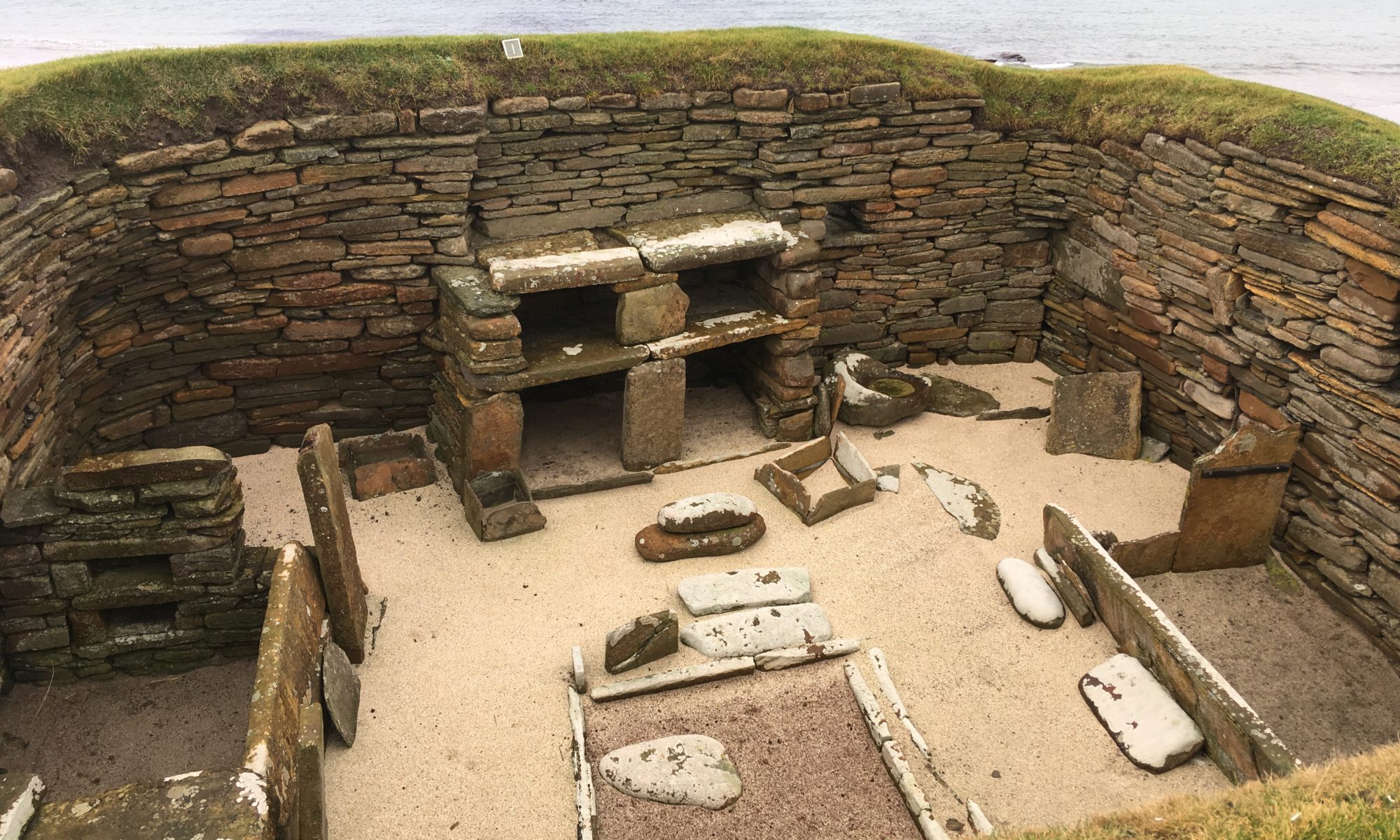Bloody Orkney
This bloody town’s a bloody cuss
No bloody trains, no bloody bus
And no one cares for bloody us
In bloody Orkney.
The bloody roads are bloody bad
The bloody folks are bloody mad
They’d make the brightest bloody sad
In bloody Orkney.
Oh bloody clouds, and bloody rains
No bloody kerbs, no bloody drains
The Council’s got no bloody brains
In bloody Orkney.
Everything’s so bloody dear
A bloody bob, for a bloody beer
And is it good? no bloody fear
In bloody Orkney.
No bloody sport, no bloody games
No bloody fun, the bloody dames
Won’t even give their bloody names
In bloody Orkney.
Best bloody place is bloody bed
With bloody ice on bloody head
You might as well be bloody dead
In bloody Orkney.
Well, I have to say that whilst it makes me chuckle, I think it’s a little harsh! I loved Orkney! Yes, it’s a little remote, a little bleak, but it is also incredibly beautiful, fascinating and friendly.
As you’ll know if you’ve been reading my blog for a while, I took the decision to take a little trip to Orkney once I reached John O’Groats. I knew that going home too quickly would be a little too much of a shock to the system, and it seemed a crime to be so close to these intriguing islands and not pop across to explore. My plan was to do a mixture of sightseeing (Orkney is famous for its history, right through from the Neolithic to Viking to World War periods) and relaxing, so I’d planned a day on the mainland at either side of my trip and then three nights on one of the most north-easterly of the islands, Sanday, to rest, read, write and take walks along its famous beaches. Definitely needed!
The ferry to St. Margaret’s Hope only took an hour and I had the company of Paul, my lovely next door neighbour who was one of the crazy friends who drove up to meet me at John O’Groats. It was really nice to have the company, it helped to have someone to babble away at! I’m not sure how many times he had to put up with me shaking my head in amazement and saying “I can’t believe I did that”, but he was very patient! It was also great to have someone to share the first few tastes of Orkney life with. Walking (yes, walking…!) from the ferry towards the little village we were staying in that night, only about half a mile, a friendly man pulled up and offered us a lift. For the first time in the entire journey I could say yes!!
When we reached our home for the night – a quaint little pub – we were shown to our simple rooms and then headed down to the quiet restaurant. There was only one other pair eating there but the bar itself was pleasantly busy with locals and I got a sense of the community spirit that still exists here but has been lost in so many village pubs back home. Once again I was glad that Paul was with me so I wasn’t drinking my celebratory glass of wine alone! The friendly waitress came over and apologised that the chef had gone home sick but that if we wanted food (er, yes!) there were a few dishes she could make herself. Thankfully, we both fancied something simple, so it worked out perfectly (and I think she gave us extra large portions, judging by the size!) and I have to admit the wine went down very well. After the buzz of the day I went to bed exhausted, still not believing that my walk had come to an end.
The next morning we were down at breakfast at the specified time, to find the lights off and nobody around. Our table was laid and the cereals etc were out, but no milk, butter etc. Once again very pleased to have each other’s company, we wondered if we had been forgotten, then Paul suggested that maybe the chef was still off sick. Ahh, that would be it! Ever enterprising, and figuring that they wouldn’t mind (they seem quite relaxed, these Orkney folk) we headed into the kitchen and helped ourselves to milk, butter and the kettle. I made tea, Paul made toast, and sitting down to our breakfast we chuckled about having to survive in “the wild”. And then, to our slight embarrassment, in walks the owner, ready to make our breakfast! Oops! We sheepishly admitted we’d helped ourselves, and I couldn’t decipher whether she was half amused, pleased, surprised or just still half asleep! Either way, she cooked me some lovely scrambled eggs which complemented my makeshift breakfast perfectly.
We headed out to catch the bus to Kirkwall, the main town on Orkney. Oh, one thing I learned very quickly, it is most definitely “Orkney”, not “The Orkneys”. That’s one way to get a glare from a true Orcadian! Well, maybe not a glare. Perhaps a mildly exasperated but patient sigh… I still haven’t worked out whether you are “in” Orkney or “on” Orkney though… Anyway, there is a surprisingly good bus service in/on Orkney. The buses are frequent, clean, efficient and, the best thing, they tie up with other forms of public transport! The buses actually meet the ferries. I swear the rest of the country could learn something from them! The other thing I love is that you can hail a bus from anywhere, as long as it’s safe (except in Kirkwall where there are designated bus stops). You just stand by the road and wave! Our chosen bus-waving spot was just by the bay and we gazed out over the perfectly calm water, breathing in the beautifully fresh, clean air. A storm was supposed to hit later but right now, amidst this stillness, it was hard to imagine!
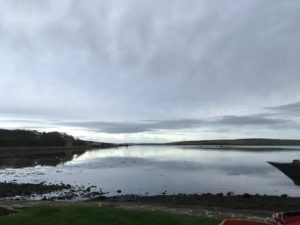
The journey to Kirkwall was probably the most scenic 30 minute bus trip I have ever taken. Sea every which way, little beaches and the outline of other islands and the hills of Hoy on the horizon. The island of South Ronaldsay (where we stayed the previous night) is linked to mainland Orkney (and a couple of tiny islands in between) by four causeways built at Churchill’s command during the war, to prevent German submarines entering Scapa Flow where the British naval fleet was based. The causeways now provide a very useful road transport link!
Arriving into Kirkwall we were surprised at how big it was. Part of me had expected a small-ish town and although it certainly wasn’t massive, it was definitely much more than a couple of houses, a ferry terminal and a corner shop! I was first struck by the exciting-looking new hospital being built on the edge of town (coolly doughnut-shaped) and then by the big Tesco and Lidl stores side by side near the bus station. But the best bit for us was wandering around the stunning cathedral, the ruined Bishop’s and Earl’s palaces and the fascinating Orkney Museum which was a treasure trove of artefacts and information right back from Neolithic times (c.5000 years ago) through to the modern day. We were so absorbed we nearly lost track of time and suddenly realised we didn’t have long before our respective ferries were due! Paul was heading back to mainland Scotland and I was headed to Sanday, an hour and a half’s ferry ride away.
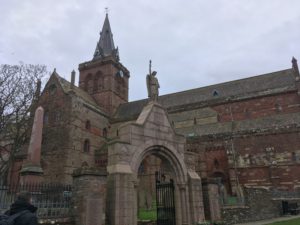
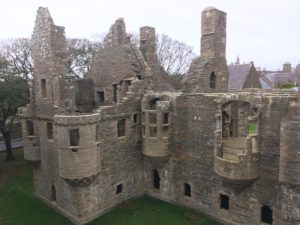
I was relieved that the ferry was still running – Ex-Ophelia (the remains of the hurricane headed over from the US) was due to pass through later in the evening and there was a possibility some of the sailings might have been cancelled or brought forward. I was also glad I wasn’t going to be camping through the storm! The ferry pulled out of Kirkwall just before 3:30pm but already the sky seemed to be darkening, the automatic street lights flickering on. I knew we were fairly far north but it seemed a little early for night to be falling! It soon became apparent that it wasn’t nightfall – the eerie dusky-grey-yellow haze in the sky was the brewing of a brilliant storm. The colour was down to the hurricane blowing Saharan sand up into the atmosphere, but the whole sky and air had a feeling of bated breath, anticipation, the build up of Nature’s energy.
As the ferry pulled into the dock and I jumped onto the Sanday bus (a community-run minibus/taxi service) the five wind turbines on the south-eastern end of the island loomed out of the moody sky, tall, graceful, stark. A vital source of energy for the island, which although connected to the National Grid, sells electricity back to it! There were a couple of other islanders on the bus and I was the last to be dropped off so I had quite a tour of the island. It is only 16 miles long, and narrow, with a bit sticking out which makes it look like a chunky, upside down T on the map. The bus driver acted as my guide, pointing out some of the interesting features we passed, including the huge sand dunes at Cata Sand and the main village, Lady, with its community centre, heritage centre and shop. Across the flat, open space of the island, and its countless beaches and rolling surf, the sky was glorious, and it wasn’t long before the storm broke. Retina-burningly bright flashes of lightning lit the sky, followed by the searing crack of thunder and its growling rumble fading away into the distance. The air was perfectly, breath-holding-ly still in between flashes but as we watched out for the next we could all feel the quiver of energy, the anticipation and excitement that comes with such a storm. I made it to my home for the next three nights just before the rain came. Proper, stormy rain. The type of rain that falls in heavy sheets and makes you call any other rain shower you’ve experienced in the past a mere drizzle. The type of rain that is made for curling up on the sofa with a cup of tea while you listen to it pounding out its tune on the roof. And then came the wind. Gusting, gale force winds, throwing the rain in hellbent splatters at the window. I hugged my tea a little closer and once again thanked goodness that I wasn’t camping!

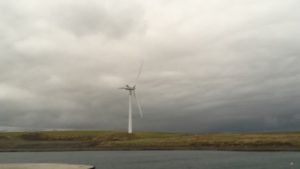
The next three days were spent pretty much as I had planned. I had lie-ins and drank tea in bed while writing and brainstorming about what I’d learned from my journey, what I was going to do when I got home, where I wanted to focus my business. I went for gentle strolls along the beach and noticed how it changed each day and in different light. The first morning the winds made it hard to stand, to walk, to breathe. The sea was whipped up into a boiling frenzy of waves and foam, the only real visual indication of the wind’s force given the absence of trees (they were all cut down for wood thousands of years ago and never replanted), and the few birds who braved the ex-hurricane fought to fly in a straight line. It was exhilarating! I had wrapped up in multiple layers, hats and gloves and was toasty warm but the wind made my eyes and nose stream. I walked around the bay and up to a cairn on a little peninsula where the tumultuous sea spread out all around me, the waves from the east crashing on rocks below, the water in the bay behind me slightly more sheltered. The water of the loch behind the house was choppy but provided some shelter for ducks, sea birds and swans. All around was space. A handful of buildings huddled down against the weather, small farms dotted around the landscape, but all else was just water, land and sky. It was wild and glorious! I had only walked about half a mile, the weather and my tired legs deterred me from going too far, but I didn’t need to. Wilderness and space was right here on the doorstep! As I retraced my steps to the house a few seals popped their heads up out of the water, curiosity beating their desire to shelter out of the storm down below the waves. Orkney has 15% of the world’s population of grey seals and a large number of them make their home on Sanday’s beaches. They’d even had their first seal pup of the season just before I arrived. Jo my host showed it to me, fluffy and white, on the Sanday seal cam.
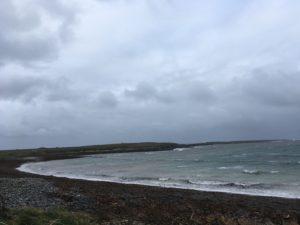

My hosts were very generous and as I didn’t have a car with me they took me on a tour of the island and ran me to the two shops on the island to pick up some food. These shops were awesome! Considering how small they were they had absolutely everything you could need. They even had a decent selection of gluten free items and dairy free milk! Jeff was explaining that the shops basically stocked whatever people wanted and anything they didn’t stock they could usually get hold of. Sometimes you just needed to be a bit organised and remember to ask for it a few days in advance (something most of us don’t do much of these days, with everything on demand). But then life here is much slower, much more laid back, and time isn’t so much of an issue. What did surprise me at first was that Jo and Jeff have only been back to the mainland twice in the four years they’ve been living in Orkney. Once for Jo’s daughter’s wedding and once for a hospital appointment in Aberdeen (a three day round trip for one appointment!). They even don’t go over to mainland Orkney all that often, as they can get hold of pretty much everything they need on Sanday, and even a trip to Kirkwall involves carefully planning around the two ferries a day and often can result in needing to spend a night “in town”. At first I thought this must leave them feeling incredibly isolated, but it’s actually the opposite. The islanders are friendly and involved. They all chip in, they all help each other out. There is a thriving school and lots of community activities. I expected an island with a population of 500 to be insular, old fashioned, sleepy, but although it is certainly quiet and peaceful (don’t go there if you’re looking for a Chinese takeout or a cinema etc), and it is old fashioned in its values and behaviour (nobody locks their door and keys are left in car ignitions because the ferry owners would immediately notice if a stranger was driving somebody else’s car), it was incredibly open, welcoming, and progressive. My hosts’ next door neighbour recently married his boyfriend and they are both going to be living on the island. Amazing! Other random facts include drivers not needing a drivers licence on the island – they can drive on a provisional licence indefinitely provided they don’t leave the island, and similarly cars don’t need at MOT, because there isn’t a garage to test them!
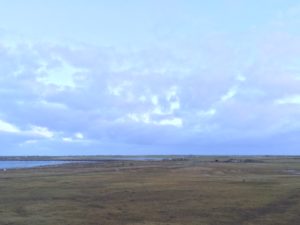
Sadly not all the islands are thriving quite so much. I didn’t visit any others (it’s quite an epic and logistically challenging trip to island hop unless you take the plane) but I learned in particular of little North Ronaldsay, the most northerly of the islands (and famous for its seaweed-eating sheep!), which has a population of just 65 and their last child just left school. But I really hope Sanday continues to thrive as it is a beautiful place. I don’t feel I really did its beaches, nature or history justice, but it definitely gave me what I needed – peace, space and time to relax and think.
All too soon it was time to return to mainland Orkney and the minibus and ferry journey was repeated in reverse. I loved listening to the thick Orcadian accents of the locals chatting on the bus. I had to really listen hard to understand what they were saying, especially as they kindly included me in their conversation! The light was fading as the bus dropped down the only hill on Sanday towards the ferry dock, just as the ferry was approaching the island, its lights shining brightly out of the dusky gloom. Once on the ferry I watched Sanday slowly shrink and disappear into the twilight until only the froth-topped waves trailing behind the ship were visible. The trip back to Kirkwall took a little longer than the outward journey as this time the ferry stopped off at Eday, another of Orkney’s islands, dropping off and picking up a handful of passengers and cars.
It felt strange to be back in Kirkwall again, I guess on reflection it’s the only place on this trip that I’ve actually returned to. It also seemed quite big and bustling after the peace of Sanday. I had to remind myself I was still on a relatively remote island! The supermarkets were useful but seemed excessive in their stock – after all, those little island shops had pretty much everything anyone needed, so what else was filling all these shelves?! The choice was almost overwhelming, but I picked up a few things to cook for dinner and to eat for lunch the next day and escaped as quickly as I could. I was fortunate to have a room to myself at the hostel but there were some people in the living room who were nice to chat to, and I realised that this was effectively the last night of my trip before I started heading home, which was a weird realisation! I had one day left of exploring the island and then it was the night ferry to Aberdeen and then gradually making the homeward trip from there.
For my last day I had decided to hire a car so I could explore properly (public transport is brilliant for getting around the island but not for sightseeing). I suddenly realised when I sat in the car that I hadn’t driven for nearly 4 months…eek! Thankfully it really is like riding a bike and the roads are quiet and decent, so I quickly relaxed and enjoyed the new form of transport. It was quite refreshing to be able to pootle about and not have to think about carrying all my stuff, or how far anything was! Even so, there is a huge amount to see on such a tiny island and I had to choose my sights carefully. I settled on heading to the Stones of Stenness, the Ring of Brodgar (both incredible Stone Age standing stone circles, pre-dating Stonehenge), Scara Brae (Orkney’s most famous site, an incredibly well-preserved stone-age village), Mar Wick (a beautiful bay full of sea birds and a prominent headland), and Maeshowe (a spectacular chambered cairn).
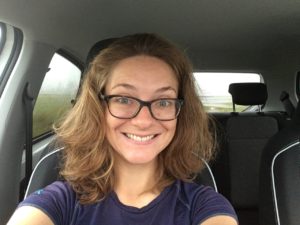
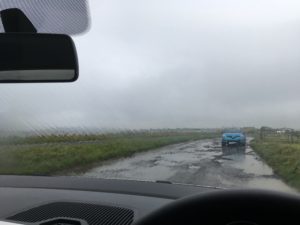
All were fascinating. Only a handful of stones remain at Stenness but they are huge and intriguing. The Ring of Brodgar, just up the road, is much more complete and stands on a slight rise overlooking two lochs and the hills in the distance. It is incredible to think that these enormous stones were erected 5000 years ago. To think that there were organised communities living all that time ago. Living, working, farming, socialising, worshipping. And yet we only know fragments about their lives. I suppose it is remarkable just how much we do know, but so much has to be left to the imagination. Scara Brae gives us more of an idea. It is a village of houses built out of stone partially (and purposefully) buried in earth mounds, joined together by narrow passageways. The village was only discovered in the 19th century when a massive storm blew away the sand that had covered the village for thousands of years. The village itself is tiny but there is a fascinating exhibition explaining what is known about the village and the people who lived there, with artefacts discovered during the excavations such as whale bone jewellery, cattle bone and stone tools, crude pots and flint arrowheads. There is a reconstruction of what a complete house would have been like that you can walk into. I was blown away, and still can’t get my head around that there were people living in peace and civilisation all that time ago. What on earth happened in the thousands of years in between?!
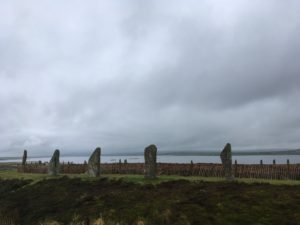
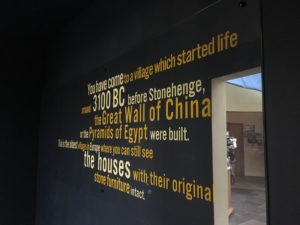
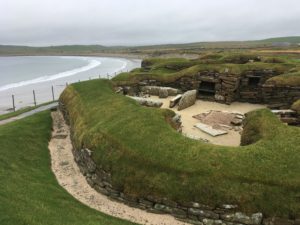
After a brief trip to sleepy Stromness, the second town on the mainland (which was very beautiful and I wish I’d had more time to explore), my final visit of my day was to Maeshowe, a magnificent chambered cairn. Visits are by guided tour only but I was the only person on my tour (one of the benefits of visiting in shoulder season!) so I had the knowledgable guide, and the chamber, all to myself. From the outside it just looks like a big grassy mound, with sheep nonchalantly grazing on and around it, unaware of the historical and anthropological significance of the ground beneath their feet. The entrance to the main chamber is through a long, low and narrow entrance “hallway”, and you need to crouch right down to walk along it. The main chamber itself is very tall, cathedral like, but not large. Massive stone pillars form the corners but they are not thought to be structurally important (one theory is that they were erected before the cairn itself was built) and there are three small chambers off the main chamber. The purpose of the cairn is a mystery but it is thought that it had some relevance to worship and was potentially (but probably not exclusively) used for burials. Its position is significant – at sunset on the winter equinox the sun shines directly up the entrance passage and lights up the wall of the back chamber. But perhaps the most fascinating thing to see in the cairn comes from a later period in history. Sometime in the 12th century Vikings broke into the cairn and sheltered there from a fierce snow storm for 3 days. The graffiti they carved into the walls is the largest collection of Viking runes outside of Scandinavia, and it’s fascinating! Most of them say something mundane along the lines of “Frank carved these runes” (the Viking equivalent of “Frank was here”), but the inscriptions give an indication of the pride the vikings (both male and female) took in their rune carving. One boasted that “the finest rune carver west of the sea carved these runes”!
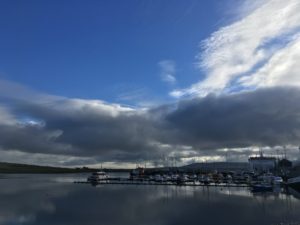
I headed back to Kirkwall feeling that I’d barely scratched the surface of this fascinating island but so glad that I had come at all. It was a satisfying end to the trip and the sky treated me to a beautiful sunset to round the day off. I sat by a little lake, “the Peerie Sea”, in Kirkwall as the light faded from the sky and was replaced by the orange glow of street lights. I was sad to be leaving, but it seemed right too. I felt ready to start the journey home.
